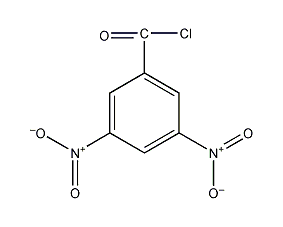
Structural formula
| Business number | 02FM |
|---|---|
| Molecular formula | C7H3ClN2O5 |
| Molecular weight | 230.56 |
| label |
3,5-dinitrobenzoyl chloride, 3,5-Dinitrobenzoyl chloride, 3,5-Dinitrobenzoicchloride, 3,5-Dinitrobenzoyl, 3,5-Dinitro-benzoylchlorid, Dnbc, Aromatic nitrogen-containing compounds and their derivatives |
Numbering system
CAS number:99-33-2
MDL number:MFCD00007248
EINECS number:202-750-6
RTECS number:DM6637000
BRN number:990249
PubChem number:24866325
Physical property data
1. Properties: Yellow crystal.
2. Density (g/mL, 20℃): Undetermined
3. Relative vapor density (g/mL, air=1): 7.6
4. Melting point (ºC): 66~68
5. Boiling point (ºC, normal pressure): Undetermined
6. Boiling point (ºC, 1.5996kPa): 196
p>
7. Refractive index: Undetermined
8. Flash point (ºC): Undetermined
9. Specific rotation (º): Undetermined
10. Autoignition point or ignition temperature (ºC): 380 (dust cloud)
11. Vapor pressure (mmHg, 20.2ºC): Undetermined
12. Saturated vapor pressure (kPa, ºC): Undetermined
13. Heat of combustion (KJ/mol): Undetermined
14. Critical temperature (ºC): Undetermined
15. Critical pressure (KPa): Undetermined
16. Log value of oil-water (octanol/water) partition coefficient: Undetermined
17. Explosion upper limit ( %, V/V): Undetermined
18. Lower explosion limit (%, V/V): Undetermined
19. Solubility: Soluble in ethanol, acetone, benzene, Easily soluble in sodium hydroxide aqueous solution.
Toxicological data
Mutagenicity: Mutant microorganism test: bacteria-Salmonella typhimurium, 100μg/plate;
Ecological data
This substance is harmful to the environment, and special attention should be paid to the pollution of water bodies.
Molecular structure data
1. Molar refractive index: 49.58
2. Molar volume (cm3/mol): 139.5
3. Isotonic specific volume (90.2K ): 402.0
4. Surface tension (dyne/cm): 68.9
5. Dielectric constant:
6. Dipole moment (10-24cm3):
7. Polarizability: 19.65
Compute chemical data
1.HydrophobicReference value for X log calculation (XlogP): None
2. Number of hydrogen bond donors: 0
3. Number of hydrogen bond acceptors: 5
4 .Number of rotatable chemical bonds: 1
5.Number of tautomers: None
6.Topological molecule polar surface area 109
7.Heavy atoms Number: 15
8. Surface charge: 0
9. Complexity: 275
10. Number of isotope atoms: 0
11. Determine the number of stereocenters of atoms: 0
12. Determine the number of stereocenters of atoms: 0
13. Determine the number of stereocenters of chemical bonds: 0
14. Number of uncertain chemical bond stereocenters: 0
15. Number of covalent bond units: 1
Properties and stability
Avoid contact with moist air. Avoid contact with strong oxidants and water.
Highly toxic and highly irritating to mucous membranes, skin and tissues, so avoid oral administration. Sudden mutation of microsomesTest: Typhimurium 1×10-6mol/plate. Leakage should be prevented during production, and operators should wear protective equipment.
Storage method
Stored in a cool, dry and well-ventilated warehouse. Keep away from fire and heat sources. Protect from direct sunlight. The storage temperature should not exceed 30℃. The packaging is sealed. They should be stored separately from oxidants, food chemicals, etc., and avoid mixed storage. Equipped with the appropriate variety and quantity of fire equipment. Suitable materials should be available in the storage area to contain spills.
Sealed and packaged in glass bottles and wooden boxes. Store and transport according to regulations for flammable and toxic substances. Handle it carefully to prevent damage.
Synthesis method
Originated from acid chloride of 3,5-dinitrobenzoic acid. Slowly add thionyl chloride to 3,5-dinitrobenzoic acid, heat and reflux for 4-5 hours, and recover the thionyl chloride under reduced pressure. The residue is recrystallized with carbon tetrachloride to obtain the finished product.

Purpose
It is used as a reagent for the determination of various alcohols, organic synthesis, pharmaceutical industry, and disinfection preservatives and reagents.

 微信扫一扫打赏
微信扫一扫打赏

